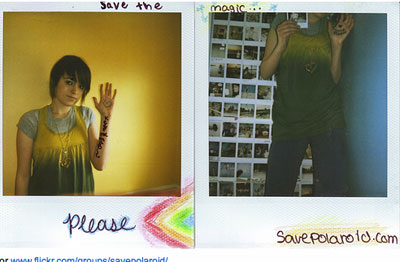Slow Boat to Economic Heaven: Grim Reality Polaroid Days
/The end of Polaroid. Who knew? I’m so immersed in today’s digital technology, that the news fell off my radar. Polaroid is done for by year’s end 2009. Thankfully, the NYT set me straight, and got me to thinking about the place of Polaroids in my life.
Polaroids reminds us of “who” we were “when”. While I never look back in life, this Polaroid news got me to thinking.
We can all lament its loss, but does Polaroid really replace digital technology? For some Cultural Creative artistic types, yes… although I suspect that the Polaroid is only a component in their artistic arsenal.
A quick trip to Flickr gives us 460,000 shots and news of a Save Polaroid association.
Save Polaroid by Kate Pulley. For www.flickr.com/groups/savepolaroid/Personally, I never thought about my Polaroid being able to do photographic “tricks”. What do I know! See Multiplex Exposure on Polaroid
clarice & …’s photostreamScanning the many commentaries about the death of Polaroids, I see two main themes emerging:
1. Nostalgia
Digital is a divide in our lives. If you are over a certain age, slide carousels and Kodaks gave way to Polaroid, and now Polaroid is obsolete in our new instant-gratification, Modern digital era.
Technology is related to a phase of your life, and life moves on.
Age happens. In the case of technology, we call it progress. In the case of mind and body, it’s a slow death, especially if you live in youth-obsessed America, where we like things new and fresh.
Some of us know a wide-range of picture-taking; others only know digital. My mission is to bring us all to Anne of Carversville.
For a large number of people Polaroids are associated with lost youth, and in these challenging times, an optimistic view of America and the future. Even the Traditionals can join the Cultural Creatives in embracing this idea that life in the Seventies was somehow glorious.
Beatsnothing.comThe Moderns want none of it. Progress is good, inevitable, and hampered by clinging to old values and memories. Besides, our brains play tricks on us. See above.
In its day, Polaroids, too, represented instant technology, but not instant by today’s standards.
We “heard” the grinding process of photo-making. Holding the cloudy print in our hand, we watched it develop before our eyes.We had a “relationship” with the creative process of the image emerging before our eyes. It was Cultural Creative “magic”.
In our nostalgia, we forget the quality, especially the color consistency and fading. As a colorist, Polaroids could drive me crazy. I also love macros.
Cultural Creatives let us down easy on the disappointments of the Polaroid experience. Smart Moderns prefer tough love, reminding us that Polaroids DNA-ridden imperfections, sort of like rickets. Hey … take it easy … there’s raw beauty in those unique imperfections!
2. Uniqueness
I think this individualistic element is why so many young people love their Polaroids.
There is only one original, although Polaroids are proliferating on sites like Ffffound. The poster may treasure the singularity of the Polaroid but there’s no hesitation to see it multiply. The desire for fame claims members of all demographic groups, less so the Traditionals. We just can’t resist putting ourselves out there in cyberspace. I should know.
Reflecting back on my own Polaroid-taking experiences, one stands out starkly in my mind. It’s a one-time event, because I was never real big on picture-taking.
A Photo, Not 1,000 Words About South America
Mr. Montrost at FlickrI arrived in Barranquilla, Colombia, prepared to write a university paper about violence in Colombia. It was my first trip out of the U.S. and I was a bleeding-heart liberal, who tried to inspire NYPD officers to help me assist drunks passed out on the sidewalks of Manhattan.
Eventually, I understood that they had more important priorities. Call me a quick study in life’s realities.
This Colombia photo image was not on my scheduled “tour”. Unfortunately, my memory has faded, and I don’t remember if I was on a boat or standing on dry ground, when my jaw dropped as far as is physically possible.
When my Polaroid began whirring, I had dreams of winning a Pulitzer.
I saw modern, hi-rise buildings rising in Barranquilla, as a sign of economic development and growing prosperity. In reality, there were two-sides to this photo. If only I had known about Multiplex Exposure on my Polaroid.
My geography offered me a unique glimpse of progress in Barranquilla, Colombia.
If I hadn’t been across the Magdalena River, or other waterway in the city, I would not have seen the unimaginable poverty living a few feet below the entrance to these splashy new buildings.
The juxtaposition of those two images grabbed my consciousness in a way that I cannot describe … squalor and poverty exceeding anything this Minnesota girl had ever seen … living in the cliff, under these modern new buildings with apartments suitable for Architectural Digest.
If you walked to the edge of the apartment garden, and looked down below … and managed not to fall off the cliff straining your neck to get a good look … you befriended visually-staggering poverty as your next-door neighbor, one floor down.
Aerial Progress in Barranquilla, Colombia Polaroid Style
I decided this was a commentary about class progress, although I understand all the arguments about economic development and prosperity eventually lifting up the people living in the mud and dirt. You might bathe in the dirty river for a long time, though, waiting for your piece of the pie in the sky.
My Polaroids were dramatic footage of the ‘haves ‘and ‘have nots’, living on top of each other . . or beneath those divine bodies — God’s chosen people — depending on your perspective.
This Barranquilla vision became sort of a Cultural Creative life metaphor for me, before the word was coined by Dr. Ray.
Traveling back to New York, I thumb tacked my Polaroids all over the kitchen. I actually remember the night the tomato sauce spattered all over them. I HATE blemishes of this kind and therefore, I took them down.
Out of sight; out of mind. Perhaps this is when my globe-trotting Peace Corps friend decided that I was a hot babe, but character-deprived. This kitchen-cabinet opinion dominated our friendship for decades.
Movin’ On Up | Anne’s Corporate Life
My Polaroid moments were the days before I flew in private jets and stayed in $500 a night hotel rooms, with a private driver at my disposal.
Thankfully, I’m not alone in losing track of my squalor photos … a multi-word search for similar images on Flickr comes up empty-handed, after trying several word combos.
One man finally helped me out. Photographer Jan Sochor seems to understand my Polaroid-taking phase, but he hangs out at Life Lounge.
Lifelounge has an interesting personality. OMG! That naked Playgirl photo of Tom Selleck is posing as a feature on moustaches!
Calvario SlumJan Sochor (website) didn’t manage to capture my beautiful hi-rises so close to slums. It’s the contrast that was so stunning in my Polaroids. But then again … I must admit that Jan Sochor gets far more intimate with his subjects than I ever did … at least in the slums of Barranquilla. (See Jan Sochor on Flickr.)
Au Revoir Polaroid
Well … au revoir, Polaroid. Thanks for the tender-hearted, grim reality memory.
I hope this well-intentioned Save Polaroid website will help you get off life support.
Passion and emotion are temporary in our lives, until a new cause strikes our fancy. I doubt your devoted lovers are willing to pay the real economic price of keeping you alive, and your corporate parent owner knows when to call it a business-decision day.
Unless, of course, you, too can participate in the federal bailout.
That’s food for thought, coming from an ace business-development consultant. Perhaps Washington can save the Polaroid. (Don’t get crazy. I’m pro-Obama but just a little concerned about the length of the helping-hand line that’s forming.) Anne
Related reading: In Good Company: Angelina Jolie, Aicia Keyes and Knowing When To Say “Flip It”
Update
on 2009-05-27 13:45 by Anne
This late-May 2009 NYT article: Polaroid Lovers Try to Revive Its Instant Film brings us up to date on the Netherlands team of Dutch scientists and “one irrepressible Austrian salesman” who have dedicated themselves to reinventing Polaroid for the 21st century.






